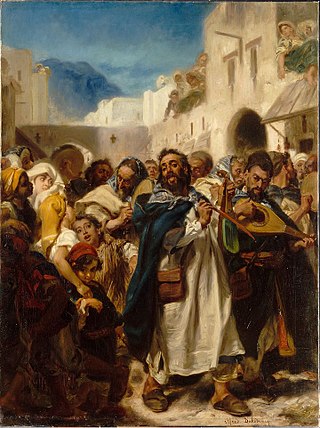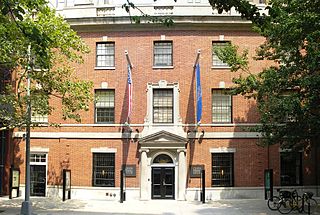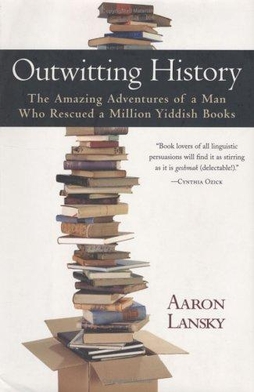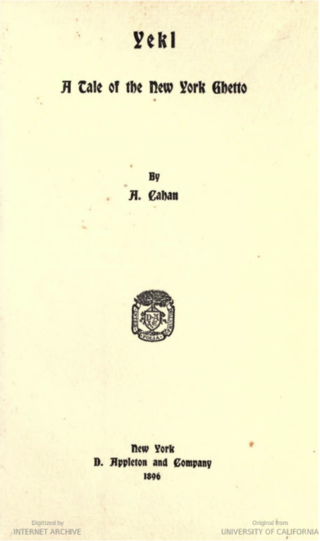
The Forward, formerly known as The Jewish Daily Forward, is an American news media organization for a Jewish American audience. Founded in 1897 as a Yiddish-language daily socialist newspaper, The New York Times reported that Seth Lipsky "started an English-language offshoot of the Yiddish-language newspaper" as a weekly newspaper in 1990.

Solomon Naumovich Rabinovich, better known under his pen name Sholem Aleichem, was a Yiddish author and playwright who lived in the Russian Empire and in the United States. The 1964 musical Fiddler on the Roof, based on Aleichem's stories about Tevye the Dairyman, was the first commercially successful English-language stage production about Jewish life in Eastern Europe.

The Yiddish Book Center Yiddish: ייִדישער ביכער־צענטער, romanized: Yidisher Bikher-Tsenter, located on the campus of Hampshire College in Amherst, Massachusetts, United States, is a cultural institution dedicated to the preservation of books in the Yiddish language, as well as the culture and history those books represent. It is one of ten western Massachusetts museums constituting the Museums10 consortium.

Abraham "Abe" Cahan was a Lithuanian-born Jewish American socialist newspaper editor, novelist, and politician. Cahan was one of the founders of The Forward, an American Yiddish publication, and was its editor-in-chief for 43 years. During his stewardship of the Forward, it became a prominent voice in the Jewish community and in the Socialist Party of America, voicing a relatively moderate stance within the realm of American socialist politics.

Jewish culture is the culture of the Jewish people, from its formation in ancient times until the current age. Judaism itself is not simply a faith-based religion, but an orthoprax and ethnoreligion, pertaining to deed, practice, and identity. Jewish culture covers many aspects, including religion and worldviews, literature, media, and cinema, art and architecture, cuisine and traditional dress, attitudes to gender, marriage, family, social customs and lifestyles, music and dance. Some elements of Jewish culture come from within Judaism, others from the interaction of Jews with host populations, and others still from the inner social and cultural dynamics of the community. Before the 18th century, religion dominated virtually all aspects of Jewish life, and infused culture. Since the advent of secularization, wholly secular Jewish culture emerged likewise.

YIVO is an organization that preserves, studies, and teaches the cultural history of Jewish life throughout Eastern Europe, Germany, and Russia as well as orthography, lexicography, and other studies related to Yiddish. Established in 1925 in Wilno in the Second Polish Republic as the Yiddish Scientific Institute.

Yiddish literature encompasses all those belles-lettres written in Yiddish, the language of Ashkenazic Jewry which is related to Middle High German. The history of Yiddish, with its roots in central Europe and locus for centuries in Eastern Europe, is evident in its literature.

Jewish American literature holds an essential place in the literary history of the United States. It encompasses traditions of writing in English, primarily, as well as in other languages, the most important of which has been Yiddish. While critics and authors generally acknowledge the notion of a distinctive corpus and practice of writing about Jewishness in America, many writers resist being pigeonholed as "Jewish voices." Also, many nominally Jewish writers cannot be considered representative of Jewish American literature, one example being Isaac Asimov. Modernism and speculative fiction are major focuses in post-Holocaust Jewish American literature.
Itche Goldberg was a Polish-born Yiddish language writer of children's books, poet, librettist, educator, literary critic, camp director, publisher, fundraiser, essayist, literary editor, Yiddish language and culture scholar, and left-wing political activist. He devoted his life to the preservation of the Yiddish language and secular Yiddish culture.

Hester Street is a 1975 American comedy drama film based on Abraham Cahan's 1896 novella Yekl: A Tale of the New York Ghetto, and was adapted and directed by Joan Micklin Silver. The film stars Steven Keats and Carol Kane, who was nominated for an Academy Award for Best Actress for her performance.
Donald Weber is a literary critic and a specialist in Jewish American literature and film studies. He is the Lucia, Ruth, and Elizabeth MacGregor Professor of English and Chair of the English department at Mount Holyoke College.

Outwitting History: The Amazing Adventures of a Man Who Rescued a Million Yiddish Books by Aaron Lansky is a memoir published by Algonquin Books in 2004. It was the recipient of the 2005 Massachusetts Book Award. The book is about the author's efforts to rescue a large number of books in the Yiddish language from destruction.
Yidisher Kultur Farband was a Communist-oriented organization, formed for preserving and developing Yiddish culture in Yiddish and in English, through an art section, a writers' group, reading circles, and publications. YKUF was founded in Paris in September 1937 by Jewish Communists and their supporters as an international body to disseminate ideology to the Yiddish-reading and Yiddish-speaking community.

Louis E. Miller (1866–1927), born Efim Samuilovich Bandes, was a Russian-Jewish political activist who emigrated to the United States of America in 1884. A trade union organizer and newspaper editor, Miller is best remembered as a founding editor of Di Arbeiter Tsaytung, the first Yiddish-language weekly published in America, and a co-founder with Abraham Cahan of the Jewish Daily Forward, the country's first and foremost Yiddish-language daily.
Jeremy A. Dauber is the Atran Professor of Yiddish Language, Literature, and Culture in the Department of Germanic Languages at Columbia University, specializing in Yiddish and Jewish literature, American Jewish culture, and American studies.

Jules Chametzky was an American literary critic, writer, editor, and unionist. His essays in the 1960s and 1970s on the importance of race, ethnicity, class, and gender to American literary culture anticipated the later schools of New Historicism and Cultural Studies in American letters.
Judah Leib Cahan, more commonly known as Y.L. Cahan, was a Yiddish folklorist.

Fradl Shtok was a Jewish-American Yiddish-language poet and writer, who immigrated to the United States from Galicia, Austria-Hungary, at the age of 18 or 19. She is known as one of the first Yiddish poets to use the sonnet form; and her stories, which were less well received than her poems in her lifetime, have since been recognized as innovative for their exploration of subjectivity, and, in particular, for their depiction of Jewish female characters at odds with traditional roles and expectations.
Harry "Hillel" Rogoff was a Belarusian-born Jewish-American journalist, author, and editor of The Forward.

Yekl: A Tale of the New York Ghetto is Abraham Cahan's first book, published in 1896. It depicts the life of Jewish immigrants living in a New York City ghetto. The plot follows Yekl, Russian-Jewish immigrant sweatshop worker, as he attempts to assimilate into American culture. His attempts are complicated by the arrival of his wife and son, which force him to decide between his Jewish identity and a new American one.













